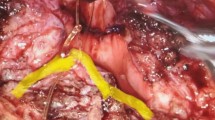Abstract
Purpose
Recently, sclerotherapy using a new sclerosing agent (aluminum potassium sulfate and tannic acid) has become widespread in Japan as a treatment for hemorrhoids. In the present study, we investigated whether sclerotherapy or surgical therapy (hemorrhoidectomy) is superior in terms of the therapeutic outcomes at 4 years.
Methods
We sent a questionnaire on symptoms and the degree of satisfaction to patients who underwent sclerotherapy or hemorrhoidectomy for grade 3 or 4 hemorrhoids in 2007, and compared the two therapies based on the responses, with respect to superiority of the therapeutic outcomes at 4 years. To identify the factors affecting the symptom-free and satisfaction rates, the univariate and multivariate analyses were performed for the following seven parameters: age, sex, degree of hemorrhoids, presence of external hemorrhoids, past history of treatment for hemorrhoids, number of hemorrhoids treated and the type of treatment.
Results
Overall, 75 % of the patients (195/260) responded to the questionnaire. In this study, the symptom-free rates were 53 % (30/57 patients) in the sclerotherapy group and 80 % (111/138 patients) in the hemorrhoidectomy group, and the satisfaction rates were 70 % (40/57 patients) in the sclerotherapy group and 88 % (121/138 patients) in the hemorrhoidectomy group. The results revealed that the type of treatment was the only factor affecting these two outcomes.
Conclusions
Our results indicate that hemorrhoidectomy is superior to sclerotherapy. These findings may be useful in the treatment of hemorrhoid patients.
Similar content being viewed by others
References
MacRae HM, McLeod RS. Comparison of hemorrhoidal treatment modalities. A meta-analysis. Dis Colon Rectum. 1995;38:687–94.
Greca F, Hares MM, Nevah E, Alexander-Williams J, Keighley MR. A randomized trial to compare rubber band ligation with phenol injection for treatment of haemorrhoids. Br J Surg. 1981;68:250–2.
Hachiro Y, Kunimoto M, Abe T, Kitada M, Ebisawa Y. Aluminum potassium sulfate and tannic acid (ALTA) injection as the mainstay of treatment for internal hemorrhoids. Surg Today. 2011;41:806–9.
Kunimoto M, Abe T, Kitada M, Ebisawa Y. Aluminum potassium sulfate and tannic acid injection in the treatment of total rectal prolapse: early outcomes. Dis Colon Rectum. 2007;50:1996–2000.
Takano M, Iwadare J, Ohba H, et al. Sclerosing therapy of internal hemorrhoids with a novel sclerosing agent. Comparison with ligation and excision. Int J Colorectal Dis. 2006;21:44–51.
Kanellos I, Goulimaris I, Vakalis I, Dadoukis I. Long-term evaluation of sclerotherapy for haemorrhoids. A prospective study. Int J Surg Investig. 2000;2:295–8.
Acknowledgments
We thank Dr. Takuro Shimbo, Department of Clinical Research and Informatics, National Center for Global Health and Medicine, Tokyo, Japan for his advice regarding the analyses. The authors declare no conflicts of interest.
Conflict of interest
There was no financial support or affiliation for this prospective study.
Author information
Authors and Affiliations
Corresponding author
Rights and permissions
About this article
Cite this article
Yano, T., Asano, M., Tanaka, S. et al. A prospective study comparing the new sclerotherapy and hemorrhoidectomy in terms of therapeutic outcomes at 4 years after the treatment. Surg Today 44, 449–453 (2014). https://doi.org/10.1007/s00595-013-0564-y
Received:
Accepted:
Published:
Issue Date:
DOI: https://doi.org/10.1007/s00595-013-0564-y




